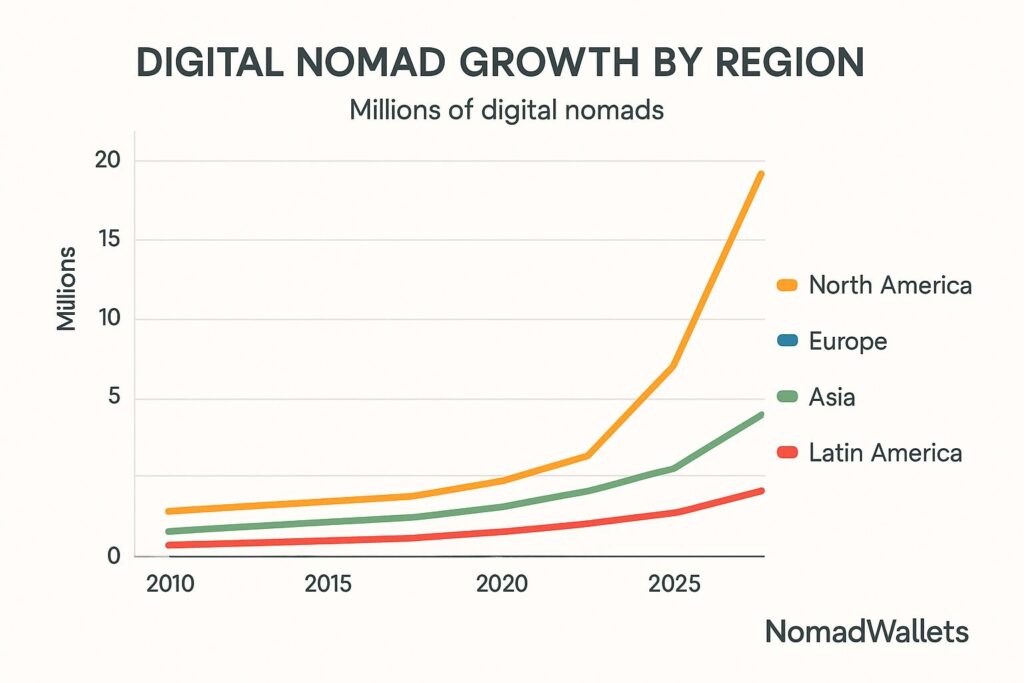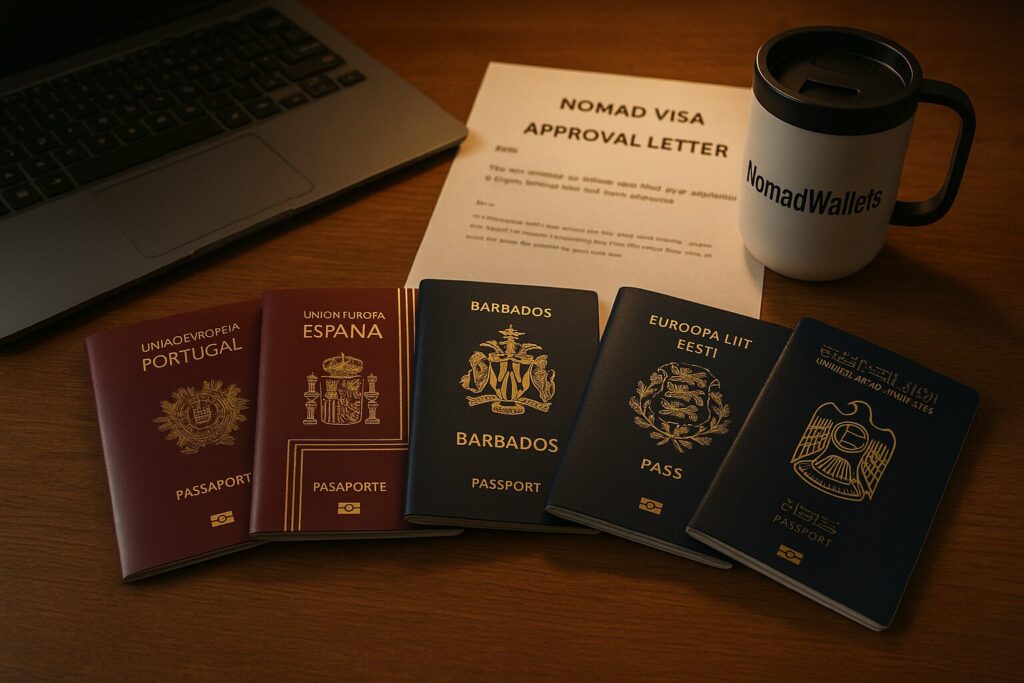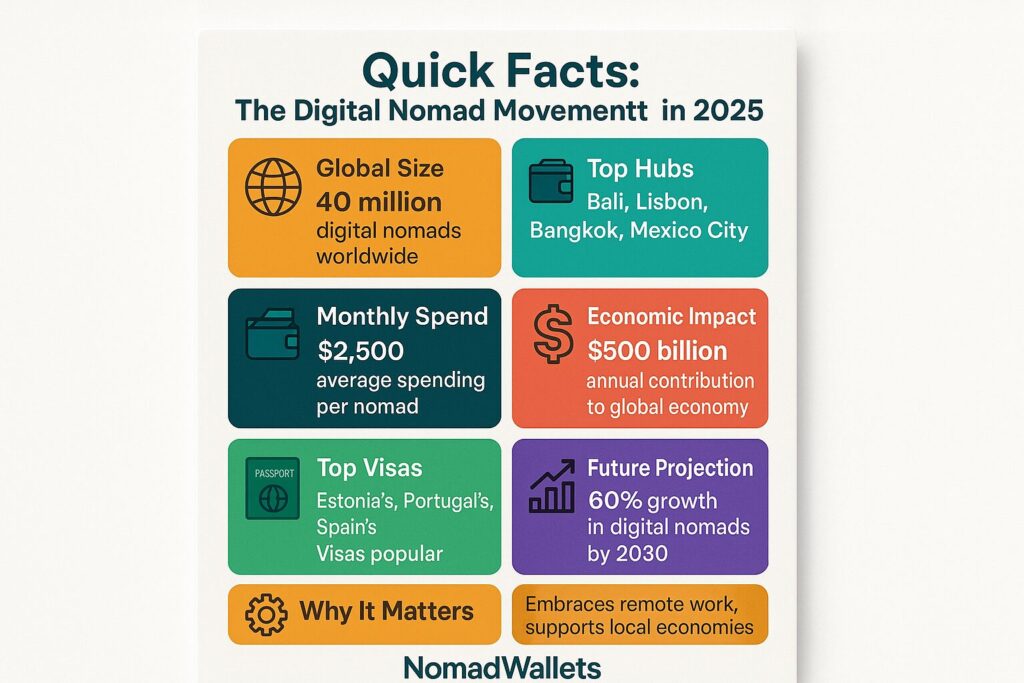
1. Opening Story – A Day in the Life of a Digital Nomad in 2025
The sun was just peeking over the horizon when Mia opened her laptop on the balcony of her rented villa in Canggu, Bali. The air carried the scent of frangipani and distant sea salt, and the rhythmic hum of scooters on the street below blended with the soft crash of waves on the beach. She had been a software project manager in San Francisco once, tethered to morning commutes and cubicle walls. Now, she was a part of something bigger: the digital nomad movement—a sprawling, global network of people who live and work wherever the Wi-Fi is strong enough and the coffee is good enough.
Mia’s day, like most digital nomads in 2025, was a blend of discipline and freedom. She started with a video call to a client in London, sipping on a cappuccino from the cafe downstairs. By mid-morning, she was exchanging ideas in a shared workspace with a German UX designer, a Brazilian marketer, and a Kenyan AI researcher. Conversations drifted easily between project deadlines and the best nearby warungs for lunch.
Halfway across the world, in Lisbon, João—a Portuguese-American copywriter—was finishing his workday just as the sunset painted the Tagus River gold. He had spent the morning editing website copy for a Canadian eco-startup and the afternoon exploring Alfama’s winding streets with a rented film camera slung over his shoulder. In between, he checked in on Slack, dropped some edits into a Google Doc, and scheduled a client call for next week—though “next week” might find him in Morocco or Cape Verde.
And then there was Lucia, an Argentine data analyst now based in Ho Chi Minh City. For her, the thrill was in the contrasts: waking up to the smell of fresh bánh mì, crunching data for a Singaporean fintech firm, then spending evenings in rooftop bars swapping stories with other expats. The digital nomad movement had given her not just a passport full of stamps, but a circle of friends that stretched from Medellín to Melbourne.
In 2025, the typical day of a digital nomad is not about escaping work—it’s about redefining it. Work isn’t bound to a single location or rigid schedule; it’s integrated seamlessly with discovery, culture, and personal freedom. That’s the quiet revolution happening across time zones and continents every single day.

2. The Origins of the Digital Nomad Movement
Long before it became a buzzword, the seeds of the digital nomad movement were planted in the late 1990s and early 2000s. Back then, the idea of working from a laptop on a tropical beach was more fantasy than reality. Remote work was rare, and stable internet connections outside major cities were even rarer. Still, a handful of adventurous freelancers—often web designers, early bloggers, and tech consultants—began experimenting with location-independent work.
By the mid-2000s, platforms like Upwork (then oDesk) and Elance opened new pathways for remote gigs, but the lifestyle remained niche. The real turning point came in the 2010s, as broadband internet spread globally, coworking spaces began popping up in unlikely corners of the world, and travel became cheaper thanks to budget airlines and home-sharing platforms like Airbnb.
Communities started forming: forums such as Nomad List, Facebook groups dedicated to remote workers, and programs like Remote Year, which brought strangers together to work and travel as a group. Yet, even in 2018, the lifestyle still felt unconventional. Most companies weren’t comfortable with fully remote teams, and “digital nomad” was a term you might hear only in certain circles.
Then came 2020. The COVID-19 pandemic forced offices to shut and accelerated remote work adoption by a decade. Suddenly, millions of people realized they didn’t need to be tied to a single location to earn a living. Those who had tasted flexibility during lockdown began exploring the idea of combining work with travel. Countries noticed and responded with a wave of digital nomad visas, making the lifestyle not only aspirational but legally accessible.
Between 2019 and 2025, the number of U.S. digital nomads surged from 7.3 million to over 18 million. Globally, the estimates range from 40 million to 80 million, depending on how broadly you define the term. This rapid expansion transformed the digital nomad movement from a subculture into a mainstream work trend, influencing policy, tourism, and even urban planning in major hubs.
The movement’s history is one of technological progress colliding with human desire for autonomy and adventure. It’s the story of people realizing that if work can happen anywhere, life can happen everywhere.

3. Measuring the Movement – Updated Stats & Growth Trends in 2025
The digital nomad movement has shifted from being a niche experiment to a measurable global trend with real economic weight. What was once a small band of freelancers with passports and laptops is now a multi-million–strong workforce shaping tourism patterns, housing markets, and even national policies.
Global Growth Numbers
In 2019, before the pandemic, the U.S. alone counted an estimated 7.3 million digital nomads. By the end of 2024, that number had ballooned to 18.1 million—a staggering 147% increase in just five years. Globally, estimates for 2025 range from 40 million to 80 million nomads, depending on the criteria used (e.g., whether short-term work-travelers are included).
The speed of growth has been unprecedented in the remote work era. In fact, between 2020 and 2025, the digital nomad population has been growing at an average annual rate of 15–17%, outpacing most other workforce trends.
| Year | U.S. Nomads (Millions) | Global Nomads (Millions) | Growth Rate (%) |
| 2015 | 4.8 | ~15 | — |
| 2019 | 7.3 | ~25 | +52% |
| 2020 | 10.9 | ~30 | +20% |
| 2023 | 16.9 | ~45 | +15% |
| 2025 | 18.1 | 40–80 | +9%–78% |
Sources: MBO Partners, Pumble 2025 Nomad Report, Global Citizen Solutions.
Demographics of the Modern Nomad
The face of the digital nomad movement in 2025 is more diverse than in previous decades. While tech workers still make up a large share, the movement now includes educators, healthcare consultants, financial analysts, designers, and even lawyers who operate entirely online.
| Attribute | Average / Trend (2025) |
| Average Age | 36 years |
| Gender Split | 56% male, 44% female |
| Education | 90% hold a bachelor’s degree or higher |
| Average Income | USD $124,000/year |
| Top Professions | Tech, design, marketing, consulting, education |
| Travel Style | 3–6 months per location (slower travel preferred) |
Regional Hotspots
While digital nomads are technically everywhere, certain cities have emerged as consistent hubs due to a mix of affordability, visa access, quality of life, and reliable internet.
| Rank | City / Region | Why It’s Popular |
| 1 | Lisbon, Portugal | Mild climate, visa options, thriving expat scene |
| 2 | Bali, Indonesia | Affordable living, strong coworking culture, beaches |
| 3 | Mexico City, Mexico | Cultural richness, time zone alignment with U.S. clients |
| 4 | Chiang Mai, Thailand | Low cost, great food, large nomad community |
| 5 | Tbilisi, Georgia | Low taxes, visa-free stays for many passports |
| 6 | Medellín, Colombia | “City of Eternal Spring”, improved safety, fast internet |
| 7 | Cape Town, South Africa | Scenic beauty, English-friendly, co-living hubs |
| 8 | Barcelona, Spain | Mediterranean lifestyle, creative industries |
| 9 | Ho Chi Minh City, Vietnam | Startup scene, affordability, street food |
| 10 | Budapest, Hungary | Central location in Europe, thermal baths, culture |
Visualizing the Growth
Imagine a curve that starts gently in the early 2010s and then spikes sharply after 2020. That’s the growth pattern of the digital nomad movement—a long tail of early adopters followed by a pandemic-fueled surge. Today, major cities actively court nomads, entire neighborhoods cater to them, and new travel–work hybrids are born every year.
The data shows this isn’t a passing fad. The number of digital nomads is set to keep rising, albeit at a slower pace than the explosive early 2020s, as the lifestyle matures and integrates with mainstream career paths.

4. Economic Ripple Effects – What You See When You Stay Long Enough
You don’t notice it your first week in a city. But stay a month, and the changes start to show.
In Canggu, Bali, I once watched a surf instructor set his board down mid-lesson just to answer a FaceTime call from a student in London. “She’s coming here next month,” he told me, “wants to work and learn to surf at the same time.” That’s the new normal — tourism and work overlapping until they’re almost the same industry.
Chiang Mai’s city council crunched the numbers and came up with something wild: digital nomads spent around $500 million there in 2024. That’s not just co-working memberships. It’s late-night pad thai runs, scooter rentals, and weekend getaways that keep half a dozen small businesses afloat.
| Region | Annual Spend (USD) | Who Sees the Benefit |
| Southeast Asia | $4.1B | Café owners, scooter rentals |
| Europe | $3.6B | Train companies, local cafés |
| Latin America | $2.8B | Landlords, Spanish schools |
| Africa | $1.2B | Safari guides, craft markets |
Economists talk about the “multiplier effect,” but you don’t need a chart to understand it. Spend $5 on coffee, and it pays for beans from a hillside farm, wages for the barista, rent for the shop, and maybe the guitar in the corner where someone plays on Friday nights. In nomad-heavy towns, you feel that cycle everywhere.

5. Policy & Infrastructure – Governments Rolling Out the Red Carpet
Five years ago, a foreigner working on a laptop in a beach café might have drawn suspicious looks from immigration officers. In 2025, it’s more likely to get you an invitation to a government “remote worker welcome” event.
Portugal’s Digital Nomad Visa doesn’t just let you stay — it comes with a network of meetups, workshops, and coastal villages wired with faster internet than most New York apartments. Barbados? They branded their one-year “Welcome Stamp” so well, locals joke that the stamp is worth more than their passport.
| Country | Visa Length | Min. Income | The Hook |
| Portugal | 12 months | $2,750/mo | Nomad villages with sea views |
| Spain | 12 months | $2,400/mo | EU-wide travel freedom |
| Barbados | 12 months | $5,000/mo | Beachside coworking spaces |
| Estonia | 12 months | $3,000/mo | E-residency for easy business |
| UAE (Dubai) | 12 months | $3,500/mo | Tax-free income |
And it’s not just visas. Madeira turned an entire town square into a free Wi-Fi plaza. In Crete, I met a mayor who proudly told me they’d installed fiber internet “so fast you can stream three meetings and a football match at the same time.” That’s how serious the race for nomads has become.

6. The Human Side – Faces, Not Just Figures
Amara – Nairobi to Lisbon
She used to sit in Nairobi traffic, two hours a day. Now, mornings start with a bica coffee in Alfama, sunlight spilling across the tiled streets. She pays less rent here than back home — even with an ocean view.
Luca – Patagonia’s Silence
In Bariloche, Argentina, Luca codes in a cabin where the only noise is wind in the pines. “I finish work by three,” he says, pulling on a scarf, “then I hike. My old Milan office would never believe this.”
Priya – Bali’s Big Table
Priya came for one month. Two years later, she’s still here. Her co-living villa feels like family — breakfasts turn into business plans, dinners into collaborations. One housemate taught her photography; another connected her with a German client.
7. Challenges & Criticism – The Parts Instagram Skips
Let’s not romanticize everything. In Lisbon, some locals can’t afford the neighborhoods they grew up in. In Tbilisi, café prices creep up because “foreigners will pay.”
Even nomads admit the cracks: constant packing, visa headaches, the hollow feeling of leaving new friends every few months. A 2025 Nomad List survey showed 37% plan to slow down, picking “base cities” instead of endless travel.
8. Future Outlook – Where It’s Heading
Three big shifts are coming:
- AI work co-pilots — less grind, more time for travel.
- Climate migration — cooler, stable-weather spots will win.
- Blockchain contracts — instant, borderless payment for freelancers.
By 2030, predictions range from 50 to 80 million nomads worldwide, with smaller cities — Da Nang, Porto, Oaxaca — becoming the next big names.
9. Conclusion – Why It Lasts
Spend a morning in a coworking space in Medellín or on a balcony in Lisbon and you’ll see it: The Rise of the Digital Nomad Movement: Size, Growth, and Global Impact in 2025 isn’t a fad. It’s people rewriting the rules of work, one Wi-Fi connection at a time.
For Amara, Luca, Priya, and millions like them, it’s not just about working from anywhere. It’s about living everywhere — and that’s a trend no visa expiry can stop.
Ready to Design Your Own Nomad Life?
The Rise of the Digital Nomad Movement: Size, Growth, and Global Impact in 2025 shows that the freedom to work from anywhere is no longer a dream — it’s a choice. If you’re ready to swap the office cubicle for a view you’ll never forget, start planning today. Research your ideal destination, check visa options, and take that first step toward living — and working — on your own terms.
🌍 Your desk can be anywhere. Where will you set it up next?
🌍 Quick Facts: The Digital Nomad Movement in 2025
- Estimated Global Size: 40–80 million nomads worldwide
- Top Hubs: Portugal, Spain, Bali, Thailand, Mexico, Colombia, Vietnam
- Average Monthly Spend: $2,500–$4,000 per nomad
- Economic Impact: Over $12 billion in combined annual spending globally
- Top Visa Programs: Portugal, Spain, Barbados, Estonia, UAE (Dubai)
- Future Projection: Could reach 80 million by 2030
- Why It Matters: Drives local economies, sparks cross-cultural exchange, reshapes global work culture

Frequently Asked Questions (FAQ)
Q1. What exactly is the digital nomad movement?
It’s the global trend of people working remotely while traveling or living in different locations, often outside their home country. In 2025, it includes millions of professionals in tech, marketing, design, consulting, education, and more — all using technology to stay connected to clients or employers.
Q2. How big is the movement in 2025?
Estimates range from 40 to 80 million people worldwide, depending on how broadly you define “digital nomad.” The U.S. alone has around 18 million citizens identifying as nomads.
Q3. Which countries are best for digital nomads in 2025?
Popular hubs include Portugal, Spain, Bali (Indonesia), Thailand, Mexico, Colombia, Vietnam, and emerging cities like Tbilisi (Georgia) and Cape Town (South Africa). Factors like cost of living, internet speed, and visa options play a huge role.
Q4. What are digital nomad visas, and why do they matter?
They’re special permits allowing remote workers to live in a country legally for extended periods — usually 6–24 months — without having to apply for traditional work visas. Countries like Portugal, Spain, and Barbados have used them to attract high-spending nomads.
Q5. How much do digital nomads typically spend per month?
It varies by location and lifestyle, but the global average in 2025 is about $2,500–$4,000/month. This includes accommodation, food, transport, coworking, and leisure.
Q6. What are the downsides of the lifestyle?
Common challenges include burnout from constant travel, difficulty maintaining long-term relationships, and the rising cost of living in nomad-heavy cities. There’s also the need to navigate multiple tax and visa rules.
Q7. Is the digital nomad movement here to stay?
Yes. With global infrastructure improvements, widespread acceptance of remote work, and supportive policies, the movement is expected to grow steadily — potentially reaching 50–80 million people by 2030.
You may also like :
- Best AI Powered Investing Tools for US Nomads – 2025 Expert Guide
- Top Degrees for Aspiring Digital Nomads to Work and Travel the World in 2025
Hi, I’m Tushar — a digital nomad and the founder of NomadWallets.com. After years of working remotely and traveling across Asia and Europe, I started NomadWallets to help U.S. nomads confidently manage money, travel, banking, crypto, and taxes. My mission is to make complex financial topics simple, so you can focus on exploring the world and building true location freedom.



